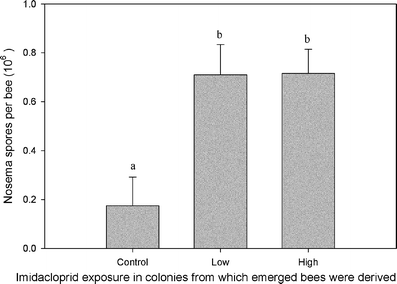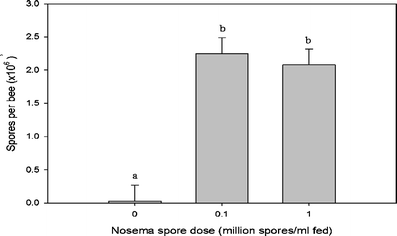Pesticide exposure in honey bees results in increased levels of the gut pathogen Nosema
- PMID: 22246149
- PMCID: PMC3264871
- DOI: 10.1007/s00114-011-0881-1
Pesticide exposure in honey bees results in increased levels of the gut pathogen Nosema
Abstract
Global pollinator declines have been attributed to habitat destruction, pesticide use, and climate change or some combination of these factors, and managed honey bees, Apis mellifera, are part of worldwide pollinator declines. Here we exposed honey bee colonies during three brood generations to sub-lethal doses of a widely used pesticide, imidacloprid, and then subsequently challenged newly emerged bees with the gut parasite, Nosema spp. The pesticide dosages used were below levels demonstrated to cause effects on longevity or foraging in adult honey bees. Nosema infections increased significantly in the bees from pesticide-treated hives when compared to bees from control hives demonstrating an indirect effect of pesticides on pathogen growth in honey bees. We clearly demonstrate an increase in pathogen growth within individual bees reared in colonies exposed to one of the most widely used pesticides worldwide, imidacloprid, at below levels considered harmful to bees. The finding that individual bees with undetectable levels of the target pesticide, after being reared in a sub-lethal pesticide environment within the colony, had higher Nosema is significant. Interactions between pesticides and pathogens could be a major contributor to increased mortality of honey bee colonies, including colony collapse disorder, and other pollinator declines worldwide.
Figures



References
-
- Bendahou N, Bounias M, Fleche C. Acute toxicity of cypermethrin and fenitrothion on honeybees (Apis mellifera mellifera) according to age, formulations and (chronic paralysis virus)/insecticide interaction. J Environ Biol. 1997;18:55–65.
Publication types
MeSH terms
Substances
LinkOut - more resources
Full Text Sources
Other Literature Sources
Medical
Miscellaneous

